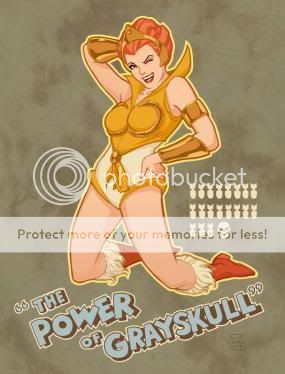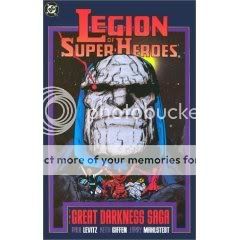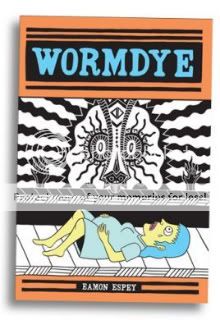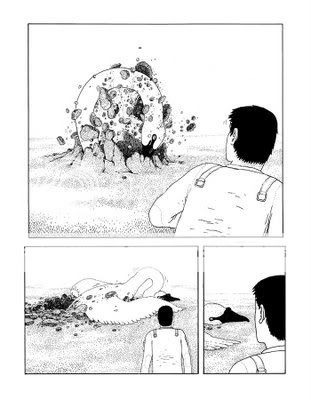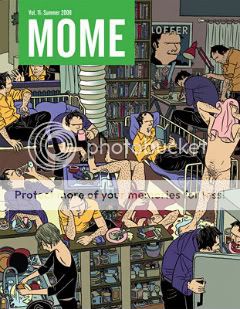[Editor’s note: This is one of a series of interviews I’ll be posting that were rescued from WizardUniverse.com’s now-defunct archives. Originally posted on March 30, 2007.]
TV Q&A: ‘BATTLESTAR GALACTICA’–MARK VERHEIDEN
The writer of the stunning Season Three finale takes us behind the shocks–and tells us what’s in store for Season Four
By Sean T. Collins
WARNING: SPOILER ALERT! If you haven’t yet watched the “BSG” Season Three finale, stop reading here, for the love of gods!
Have you lost sleep or sanity (or countless work-hours gathered around the water cooler) trying to process all the series-rocking revelations in last Sunday’s “Battlestar Galactica” season finale? Blame Mark Verheiden. As the writer responsible for the episode, titled “Crossroads: Part Two,” he set Gaius Baltar free, revealed four more secret Cylons, brought Starbuck back to life–and showed us Earth.
Wizard went to action stations with the veteran TV and comics scribe and “Battlestar” co-executive producer to look back on Season Three, look forward to Season Four and learn whether Cylons–and Starbuck–can really be trusted…
WIZARD: How did you land the writing chores for the season finale? Is that a real plum gig, or a real hard gig?
VERHEIDEN: Well, [executive producers] Ron Moore and David Eick make the decision of who writes which episodes. Some of it is rotation-based: “Who’s up?” Obviously, when you’re on the last episode, you get to be here longer. So there is that aspect, but I was flattered to be asked to do it and I had a great time doing it. I can’t really tell you exactly why [they asked me], but it’s nice to be trusted with it. By the way, I think that any of the writers could’ve handled it. It’s a great staff here. But it was great that I had a chance to do it.
You had a lot of balls to juggle in that final episode: Baltar’s trial, Laura’s cancer, Adama’s relationship with both Laura and Apollo, Starbuck’s return, the shot of Earth, the opera house dream sequences, the appearance of the Cylon fleet, the revelation of four out of the final five Cylons.…How do you even go about weaving all those threads together?
VERHEIDEN: When you’re here through the entire process, you’ve been following the strain of these stories all along. We all have ideas where we’re going with each one of those stories anyway. It just becomes an issue of sitting down and trying to order them up and figuring out a way to bring some of them to fruition or a close, and which ones do we want to continue into the next season. That’s really a process that comes out of working with Ron and David and in the writers’ room with the rest of the writers; we call that breaking the story. For every episode we do the same thing: We sit down and we look at the balls that are in the air, the stories that we want to tell, and then we break it down on note cards and put it up on a board and say, “This is how we think it should go.”
The interesting thing with “Crossroads” parts one and two is that ultimately, in the editing process, material from what was in part two ended up in part one and stuff in part one ended up in part two. It’s a little bit of a mix-and-match process. Even at that stage, we’re rethinking and configuring what we want to put in the show. Again, with so many balls in the air, I think that even after the fact–when you’re editing, obviously–you’re thinking, “Well, where do we want to present these? Where do we want to cut a story off and pick up the next story?” There are decisions like that, and it’s really just part of the process of figuring out the story. That’s how you do it. You do have a lot of things in the air, and that frankly makes it more fun.
Really? I was wondering if you went into it sighing, wondering how you’re going to pull it off.
VERHEIDEN: We do that with every episode. [Laughs] But it’s not so much a sigh of defeat, but more like, “Wow. A lot of challenges here.” It’s really great, though. One of the wonderful things about this show is the fact that there are so many places that we can turn. We have such a large cast, and each of them has their own idiosyncratic issues that they have to deal with. We have the Cylons. We have science-fiction conceits. We have interpersonal conceits. There are just a lot of ways stories can go. So rather than that being challenging–well, it’s challenging, but it’s also a wonderful opportunity because you’ve just got so many choices that you can make. You’re not locked into any one thing that you sort of need to do or tell. That’s great.
One of the big reveals for this episode was the identity of four new Cylons: Colonel Tigh, Chief Tyrol, Anders and Tory. Around my office, at least, we had a lot of people who couldn’t possibly wrap their heads around people like Tigh and the Chief being Cylons. I know that Ron Moore has said in interviews that they are, but I want to get as many people on the record as possible. So, are these four Cylons? Pinky swear?
VERHEIDEN: [Laughs] They are Cylons. No, this will not be a “Dallas” dream episode where you wake up and go, “We’re not Cylons!” Without getting into any kind of spoiler territory, we will be exploring what that means as we go into Season Four, but they are Cylons. So, harbor no hopes that it’s some kind of dream or nightmare. When we do something like this, first of all, it’s not without considerable thought and planning, and second of all, we don’t do it so that we can pull the rug out from under the audience and say, “We were kidding.” Not with this one anyway.
I’ve seen fans of the show comment that because of the leadership role these characters played in the New Caprican insurgency, it essentially makes that conflict a Cylon civil war, even if these characters weren’t consciously aware of that. Is that one of the long-term planning points that you’re referring to?
VERHEIDEN: Well, I think that what happened on New Caprica will certainly be an issue that we have to think about as we go along. Basically, they are Cylons and we’re going to approach that. I really don’t want to give anything up about what we’re doing next season… [Pause] …that… [Another pause] well, what can I say? I’m trying to think what would be interesting here. [Yet another pause] Well, I think that I’ve said it. We will be exploring what it means to have these guys being Cylons for sure. Oh yeah, I was going to say… [Super-long pause] Well, no. I will end there. [Laughs]
Clearly, they’re a breed apart. For example, we’ve seen a younger Tigh in flashback sequences, so it seems unlikely that there are thousands of regular, aged Colonel Tighs walking around on some base ship somewhere. Are those different rules for these guys something that will be coming up in Season Four?
VERHEIDEN: All stuff that we’ll be exploring. We do know who they are. So in terms of, like, if we’re just winging it and backpedaling as we go? No. We know who they are, and that is going to be a big part of what we get at in Season Four.
Switching gears for a moment, I loved Apollo’s courtroom speech in Gaius Baltar’s trial. It showed that he’s such a noble, likable character even when he’s doing something that you don’t agree with, and it also tied in all these events from the past where characters from the Galactica have committed horrible crimes of treason and been forgiven. How did that speech, and its references to those plot points from all three seasons and the miniseries, come about?
VERHEIDEN: That was a culmination of something that Ron Moore really wanted to do. The entire idea of the trial of Baltar was to explore the concept of guilt or innocence within the fleet, and also to suggest that this is a fleet that only had an ad hoc justice system. We’ve never really seen the justice system in the fleet, and I think internally we always assume that the captains of each ship always dealt with whatever issues came up on a summary basis. So we were interested in just trying to explore how you create justice in this world.
The second question, which is the one that Lee attacks in his speech, is “What is justice?” What does that mean in this particular world, where we’ve basically been reduced to 38,000 people and vengeance and attempts to get retribution for things in the past might not be as valid as they would, say, in a different circumstance. It was also fascinating, I think, that Baltar was the elected president of the 12 colonies and found himself in an untenable position. Lee’s speech was an attempt to address the practical realities of the situation that they found themselves in, and pull us out a little bit from us screaming for blood. That’s where the impulse for that came from. And again, one of the great things about working on a show that has such a rich background as “Battlestar” is that you’re able to pull from a lot of events that happened in past shows to demonstrate how the fleet’s justice system or sense of justice has been tested or not tested, or how forgiveness has been the rule of the day.
Internally, we thought one of the more interesting moments pointing out that [President] Laura [Roslin] had pardoned everyone, so we’re not quite sure why that pardon didn’t manifest itself all the way to Baltar. How come he got excluded from that when we forgave everyone else who may have actually done more heinous crimes than him? Of course, the horrible thing is that Baltar, in fact, is at least complicit in the genocide of the whole civilization, if you go back that far, but that’s kind of one that we can’t really prove. I’m sure that he would have a very facile argument as to why he wasn’t to blame. “It wasn’t me!”
As the proud owner of a homemade “Free Gaius” T-shirt, I was happy with the verdict.
VERHEIDEN: [Laughs] He’s free. Sort of.
Oh yeah–he’s been whisked away by the Cult of Gaius, or whoever these people are. Is that storyline going to dovetail with the religious aspects of the show, or is it a separate beast?
VERHEIDEN: It doesn’t really give anything way to say that we’ve always explored the role of religion in civilization and in the fleet. It’s certainly an issue that will come up, whether Baltar’s story goes that way or not; that remains to be seen. But absolutely, the role of religion is an issue that we will continue to explore. Certainly, in the fleet and in what we’ve said already, religion has played into it, as well as faith and the “polytheist versus monotheist” situation. Those things have all played a role in how we ended up where we are.
Speaking of which, at least in terms of prophecies and visions and things of that nature, Starbuck is back and has apparently discovered Earth.
VERHEIDEN: That’s what she says.
Should we trust her, Mark?
VERHEIDEN: Well, you know– [Laughs] I trust her. You don’t trust her? She said it with great enthusiasm! You’ll just have to see. I say that not meaning it in one way or the other; it doesn’t mean to trust her or not to trust her. It means that obviously, when she comes back with a piece of information that relevant, it will become an issue as we go forward.
Even just the choice of that final shot, pulling back through the Milky Way and zooming back in and showing Earth, seems to be sending a message that the goal line is in sight.
VERHEIDEN: I don’t know if the goal is in sight, but certainly the goal of the fleet is to find Earth. That [shot] was a really wonderful sort of wish of the fleet, to be there. That’s how you can take that. You’ve seen Earth. What Earth is and what it might be is stuff that’s still up in the air, but the goal of the fleet is still to find Earth. Obviously, we’re going to be exploring that. When Kara comes back and says something like that, it’s not a thread that will be dropped. Let me just put it that way.
And speaking of Earth–I think–this episode used the Bob Dylan song “All Along the Watchtower.” How difficult was it to thread that song in? That’s a huge earthquake in terms of fans’ interaction with the world of the show.
VERHEIDEN: Right. Well, Ron has said that you shouldn’t take that as meaning anything specific to, say, Bob Dylan in the ’60s when he wrote the song, except in the sense that for all we know this song and these lyrics have existed on many planes. Maybe Bob Dylan is the one who picked it up here, in our place. It gets kind of mystic here, but I don’t think that you should draw too much from that, except that there are connections and there are very many interesting eddies and byways in the universe of “Battlestar” that remain to be explored.
On a more pragmatic level, “All Along the Watchtower” was there because Ron Moore has always wanted to use that song and use it in some way where we were, again, thrilled with how it worked into this final episode, and also with the version that [“Battlestar” composer Bear McCreary] did. I thought it was suitably evocative and eerie and really worked well. In fact, I thought that the music in that episode was just fantastic all the way through.
It really conveyed the sense of borderline chaos that was gripping the fleet throughout the entire show. It lent the episode an air of weirdness.
VERHEIDEN: It really did hammer that home. I especially loved the music when Tigh, Tory, Anders and Tyrol got together, which just seemed to raise to this crescendo of, “What in the world is going on?” which is exactly what they were thinking and what we hoped the audience was thinking when we got to that point. Again, as they said, a light switch clicked, and the music was really helping to push that moment.
When Tigh walks into that scene, I believe his exact word was, “Whoa.” It was a funny moment. Even Gaius, despite having been in a very tortured and tormented place the entire season, was calling Gaeta “butterfingers” at the trial and got back to his smarmy self when the trial was over. Was it a conscious choice on your part to inject those humorous elements into what was such a momentous episode?
VERHEIDEN: Well, the Baltar character, by definition, has sort of an ironic disconnect with himself at times. I wish I could take credit for everything, but the “butterfingers,” I believe, was something that [Baltar actor] James Callis came up with. It was perfect. I mean, it was just so perfect. A lot of that is how he plays it. We think that James is a fantastic actor and brings so much to the part, and he brings this sort of naïve malevolence, or, well, I don’t even know how to put it. It’s this odd, almost disconnected from his own understanding of what he’s done, sort of defense. It’s a moral relativism, which gives so much more to each scene that he’s in.
But conscious choice? Yeah. Obviously, we scripted it, and he brings an attitude to the show that is very unique to him. It’s always fun to go to him because he brings something unusual. I don’t think that funny is necessarily the right word, but sort of ironic. Well, in the case of “butterfingers,” it was just funny.
Tigh also shined in this episode. His arc in the third season was more of a downward spiral than an arc, but this moment that one would think would shatter him became his finest hour. I found it moving.
VERHEIDEN: I’m glad. I’m glad that came across. Michael Hogan is a fantastic actor, and the Tigh character has been through a very, very difficult season on the show. There is something reassuring [about] hearing him say that he wants to reassert his humanity despite what’s happened. We’ll see where that goes, but I think that of all of the [newly revealed Cylons], he’s certainly the one who, discovering that that’s true about himself, has the most to catch up to, given what’s happened to him in the past. If he’s a Cylon, then it’s interesting what’s he gone through. Well, he is a Cylon, and so it is interesting what he’s gone through.
Given that only these four came together, can we take from that that the fifth Cylon is elsewhere?
VERHEIDEN: I think you can take that the question is still in the air.
It seems as though there’s a different explanation for Starbuck’s reappearance than the old Cylon-recycling trick, right?
VERHEIDEN: Well, again, we’re getting into where we’re going in Season Four, and we’re awfully early to be giving up things.
You can take the Fifth. There’s a lot of that going around these days.
VERHEIDEN: Yeah, I think I will take the Fifth on that. I feel more comfortable with that. [Laughs] It’s a question that’s hanging out there, and it’s a question that will be explored. In terms of who it might be and is there a fifth one–those are all things that I’d just as soon not get into because there are surprises to come.
Do you have a favorite character whom you love to get your hands on when you’re writing an episode?
VERHEIDEN: They’re all great–which is the standard answer, but they really are all great. One of the fun things about the show is that their voices are all so different. Adama’s voice–I mean, I really love writing for Adama. It’s really fun to write for Laura Roslin. I think that Tigh brings a pathos to his character that’s very interesting to try to find. His voice is one that has a tragedy to it that’s maybe even stronger than the others. But I’ll tell you, they’re all so rich, and the show has managed to invest them with such rich backstories and textures, that they’re all great to write. If I was going to pick one where when you get to them you go, “Wow, we can really go to town here,” then Tigh is someone who fascinates me, but also Adama and Laura. Both of those bring very strong personas. I say those, but I’m certainly not excluding anyone else. Starbuck is always fun and crazy. She’s such a live wire that to try and capture that is always a blast.
Is there anyone who’s been difficult to get a grasp of?
VERHEIDEN: I don’t know if it’s been difficult. I will say that when we started doing the stories on the Cylon base ship, that was a learning process internally here–just trying to get a handle on how to play those scenes, to figure out their interpersonal dynamic. It’s obviously a little different than with the humans, since there are multiples with each of them. I would say that in the two years that I’ve been here, working that out and trying to understand how that world worked was a challenge. That would be the one.
Even besides the basic nature of the Cylons–they’re not human and are fundamentally a different species, in at least some ways–there was also a different storytelling rhythm during scenes on their ships, even in the way cuts are made from shot to shot and from scene to scene.
VERHEIDEN: Yeah. We made a conscious choice to sort of present the base ship in a different way than we presented the Galactica, our side of the universe. Those were conscious choices. That also [involved] just trying to understand how these creatures, or these robots, or machines, or half-human half-machine entities, communicate with one another–an interesting and different, and yet understandable to us, way of communicating. All of those things just took time to figure out what we wanted to do there, so as challenges go, that was one of the bigger ones, trying to understand those people. By definition they are alien to us, and it’s necessarily harder to empathize with them, to understand what they’re saying and where they’re coming from.
Until the episode that focused on Boomer and Caprica Six back on Caprica, where you saw things from their point of view and learned that they truly are multidimensional characters, I was pretty sure that they were all evil all the time and everything else was just a false front. Convincing viewers that these are more than just Terminators must be a challenge.
VERHEIDEN: Right. In a way, to say that the Cylons are like the Terminator or soulless, empty machines diminishes their capacity for anything. I was going to say evil, but I don’t know that you apply evil to that. Certainly the genocide of the human race was an inherently evil act; however, that was prompted and didn’t come out of nowhere. It wasn’t just sociopathic, it came out of things that had happened prior. So it’s sort of an “understand your enemy” point of view. I don’t want to speak for Ron and David Eick, but we never wanted to end by saying, “We’re up against this soulless mechanical army.” We wanted to say that they had their points of view, too. That’s why we actually went over to the Cylon side for a while.
In many ways, the most interesting relationships on the show are in these pairings of a Cylon and a human, whether it’s Six and Baltar or Athena and Helo or Boomer and the Chief–although it turns out that that’s not a Cylon-human pairing after all.
VERHEIDEN: Well, Chief and Cally…
That’s true–you’ve created more of those relationships with these new revelations.
VERHEIDEN: Yes, and we also created a situation where people have a secret. And strictly from a dramatic standpoint, that’s always interesting to explore. We’ve got four guys with a pretty big secret now.
How does it feel to work on a show that is this good?
VERHEIDEN: It’s fantastic. You can take one step back and watch a show and go, “Wow.” I mean, I’m a fan of the show, too. So when I can take a step back and look at the first five episodes that we did this year–and look at most of the episodes, actually–I can go, “It’s really a wonderful thing to be on a show that you can be so proud of.” I’ll tell you from a writing standpoint, too, the great thing is being able to explore concepts and conceits and political dynamics and nonpolitical dynamics and character interactions that you just wouldn’t get to do if you were doing–not to put down cop shows, but you just couldn’t go there. By being a science-fiction show and by having created the political dynamics we have, we can go and explore relationships and philosophies and things that you would get in big trouble if you tried to do in sort of real-world terms. But since it’s one step removed in our “Galactica” universe, we can explore them with an abandon. That’s been almost a liberating experience, as a writer, to do. It’s been just great.
Does it burn you at all that you guys haven’t been recognized by the Emmys? I know it’s baffling to a lot of fans. Is that something that’s even on your radar screen?
VERHEIDEN: Do we read the nominations when they come out? Sure. [Laughs] I speak for myself, but you can’t live your life worried about whether or not you’re going to win a prize. You have to go ahead and do the best show you can, and if we get recognized, great, and if we don’t, we still know it’s a great show. I mean, we did win a Peabody, which is one heck of a recognition. I don’t feel like we’re under-recognized in terms of people who have found the show and can appreciate what we’re doing. In terms of Emmys, it would be wonderful, but does my world turn around it? No.
I guess this is a fatuous question considering your job, but how much attention do you pay to “The Sci Fi Channel is picking the show up for 13 more episodes, and now it’s 22, and now there’s a special two-hour movie-type episode in the middle?”
VERHEIDEN: I pay intimate attention to that. [Laughs] Those things I do pay a great deal of attention to, because that impacts what we’re doing here.
It obviously makes a big difference in how you write the show.
VERHEIDEN: Yeah, and it’s great to have 22 [Season Four episodes] for sure, I’ll say that.
I just don’t know how I’m going to wait until 2008 for them.
VERHEIDEN: Well, there is the two-parter that will be on before that.
Of course! Do you know when that’s airing?
VERHEIDEN: I have not heard. Maybe someone else knows it, [but] I’ve only heard the generic term of “fall.” So hopefully you’ll have that.



